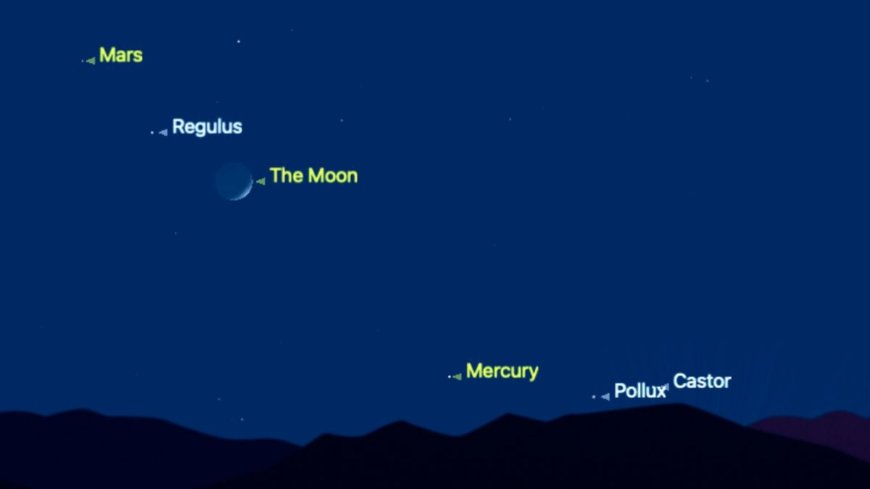Catch the crescent moon, Mars, and Regulus in a celestial dance this weekend
On June 28 and 29, watch as the waxing crescent moon aligns with Mars and the bright star Regulus in the night sky. This rare celestial event will be visible above the western horizon in the hours following sunset. Don't miss this unique opportunity to witness the moon passing close to Mars and Regulus before they disappear below the horizon.

The moon appears close to the bright star Regulus and Mars in the hours following sunset on June 28.
In the hours following sunset on Saturday (June 28), the waxing crescent moon will line up with Mars and the bright star Regulus above the western horizon — before swiftly slipping out of view.
Stargazers in the U.S. will find the slender form of the crescent moon roughly 20 degrees above the western horizon right at sunset on Saturday. The following hour will see Mars and the bright star Regulus line up to the upper left of the lunar disk, becoming visible as dusk gives way to the coming night.
The trio will follow the sun below the horizon a mere three hours later, so be sure to catch the celestial alignment before it disappears!
The moon will appear close to the lower left of Mars on the night of June 29 for viewers in America. (Image credit: Starry Night.)
The following night, Sunday (June 29), will see the waxing moon jump to the lower right of Mars, with its crescent form appearing to sweep underneath the Red Planet. The moon and Mars will pass within 1 degree of one another before slipping below the western horizon.
TOP TELESCOPE PICK: Want to see Mars, Regulus, and the moon up close? The Celestron NexStar 4SE is ideal for beginners wanting quality, reliable and quick views of celestial objects. For a more in-depth look at our Celestron NexStar 4SE review.
Some well-positioned viewers will witness the moon pass directly in front of Mars, blocking the planet from view, according to stargazing website in-the-sky.org. This phenomenon is known as an \"occultation\" and is only possible because of the moon's relative proximity to us, which can make its position shift by around 2 degrees in the night sky depending on where you're viewing it from on Earth.
The lunar occultation of Mars will be visible from parts of Peru, Ecuador, Colombia and Clipperton Island in the hours following 6:57 p.m. EDT (22:57 GMT) on June 29.
Night sky enthusiasts looking to capture the next big celestial alignment should check out our guides to the best cameras and lenses for astrophotography available in 2025. Those hoping to get a closer view of the cosmos should also read our roundup of the top telescopes and binoculars with which to explore the night sky.
Get the Space.com Newsletter Breaking space news, the latest updates on rocket launches, skywatching events and more! Contact me with news and offers from other Future brands Receive email from us on behalf of our trusted partners or sponsors
Editor's Note: If you capture a picture of the moon with Regulus and Mars and want to share it with Space.com's readers, then please send your photo(s), comments, and your name and location to [email protected].
What's Your Reaction?
 Like
0
Like
0
 Dislike
0
Dislike
0
 Love
0
Love
0
 Funny
0
Funny
0
 Angry
0
Angry
0
 Sad
0
Sad
0
 Wow
0
Wow
0






















































































































































